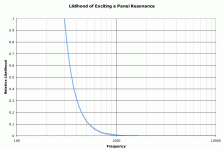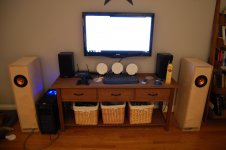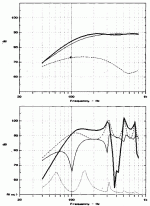Similar to the Pencil 12.
It can do, although it's a bit sweeping to say it automatically will in all times & conditions. BW limiting will increase power handling & reduce AMD / FMD (doppler). How noticeable or otherwise depends on the box, system, room, material & how hard you're driving it.
It can do, although it's a bit sweeping to say it automatically will in all times & conditions. BW limiting will increase power handling & reduce AMD / FMD (doppler). How noticeable or otherwise depends on the box, system, room, material & how hard you're driving it.
Is the functional bandwidth of the cabinet different than that of the driver?
Go back & reread post 29.
Let's consider that the energy to excite a resonance is inversly proportional to the 4th power of the frequency.
Let's assume that a typical MDF panel resonantes at 300 Hz. Now consider how much less likely a resonance is to be excited if we can push the panel resonance up to 1000 Hz.
(1/300^4)/(1/1000^4) = 123 times less likely. In a full range speaker one we have energy into the cabinet all the way up, but one can arbitrarily pick a point using the "less likely to get excited" criterion to decide where the functional bandwidth of the cabinet extends.
The chart shows relative likelihood of exciting a resonance at that frequency. Below ~300 Hz, the 4th order supposition breaks down
dave
Attachments
Only insofar as there is a common belief that a dense material is automatically 'unresonant.'
Ignoring differences in damping qualities, given 2 panels of the same stiffness, the less dense one (ie the lighter one) is better given the criteria in my last post as resonant frequency is proportional to mass.
dave
Thank you Dave and Scott for the lessons. I know its gets repetitive. I am cutting the wood for the enclosures as I type. Hope to report back soon with picks, comments and 10 fingers.
Side note: The driver needs to be recessed about 3/8" leaving only 3/8". Do I need to provide more support for driver?
Side note: The driver needs to be recessed about 3/8" leaving only 3/8". Do I need to provide more support for driver?
Last edited:
Side note: The driver needs to be recessed about 3/8" leaving only 3/8". Do I need to provide more support for driver?
We always add a driver brace, so the lack of infringement on the back-side of the driver is a bonus (we also champher the back side to open it up even more). Mounting the driver on the backside of an aluminum plate/subbaffle 3-4mm thick (and champhered on the front), would take that to extremes.
dave
Thank you Dave and Scott for the lessons. I know its gets repetitive. I am cutting the wood for the enclosures as I type. Hope to report back soon with picks, comments and 10 fingers.
Side note: The driver needs to be recessed about 3/8" leaving only 3/8". Do I need to provide more support for driver?
These do look so yummy when rebated for flush mounting, but the thick resin composite mounting flange does somewhat complicate things.
So yes, since I've been quite happy with the sonic results of a well braced 15mm BB ply cabinet, I usually laminate a small plate of 9mm material on the rear side of cut-outs. Of course one could always machine same in 3mm aluminum and tap for machine screws for the driver mount - but that'd be a bit obsessive, doncha think?
edit: now that's freaky - Dave's reply above posted while typing the above an answering the phone
cheers
Ignoring differences in damping qualities, given 2 panels of the same stiffness, the less dense one (ie the lighter one) is better given the criteria in my last post as resonant frequency is proportional to mass.
Agreed, per my previous posts. Give me a panel with a high MOE & decent bracing any day.
Scott,
Do you have the modeled response for the 10.2 like you do for the 12? Also, do you agree with Dave that relieving the FR of its low end repsonsibilities will improve its mid and high frequencies?
Provided you truly relieve the heavy lifting with HP filter and direct amplification of the wide-band driver, you will also appreciate substantially reduced excursion, distortion and power compression, and increased dynamic headroom / max SPLs. This is as true with "full-range" drivers as with more conventional active multi-way systems with W/M/T.
The trick is deciding where to XO, and the number and location(s) of woofer(s). Note that while individual room dimensions/shape will determine the exact transition point, at frequencies often chosen for "subs" (why do I hate that word?) ,the optimal position of LF drivers may not necessary be common with those for the upper portion of bandwidth.
"subs" (why do I hate that word?)
Because boom, boom subs designed to appeal to the unsophisticated explosion loving HT crowd have given them a bad name. And because many "subwoofer" drivers are not extended enuff to integrate well.
dave
Provided you truly relieve the heavy lifting with HP filter and direct amplification of the wide-band driver, you will also appreciate substantially reduced excursion, distortion and power compression, and increased dynamic headroom / max SPLs. This is as true with "full-range" drivers as with more conventional active multi-way systems with W/M/T.
The trick is deciding where to XO, and the number and location(s) of woofer(s). Note that while individual room dimensions/shape will determine the exact transition point, at frequencies often chosen for "subs" (why do I hate that word?) ,the optimal position of LF drivers may not necessary be common with those for the upper portion of bandwidth.
My eventual woofer addition will be in a FAST type speaker. My hope and current plan is to match the A10.2 with two CA22RNX woofers(I have one pair already). Pass Aleph J monos driving the A10.2 and mono F4's driving woofers. I don't think I could convince the wife about having subs placed strategically though-out the living area unless they could be built into current furniture. I am gearing more towards stereo over HT anyway.
Cork should be good in absorbing Vibrations! 
here Midrange Section damped with: http://www.6moons.com/industryfeatures/roadtourserbia/raal_2.html
An externally hosted image should be here but it was not working when we last tested it.
here Midrange Section damped with: http://www.6moons.com/industryfeatures/roadtourserbia/raal_2.html
Last edited:
Routed out the speaker holes and definitely feel like some added bracing is necessary. I have left over 3/4", but feel like this is big enough that it could affect cabinet response. I also have 1/4" plexiglass, but it is not very stiff. Don't want to buy 3/8 just for backing and not real sure it would be good for bracing. ANy comments. ChrisB, have you worked with raw veneer before? found some very nice stuff, but it is raw and thinner than I am used to.
Drivers are installed now. Just testing them out. Have to add stuffing and braces. One problem, I cant find the woofers. Sounds great Scott and Mark and I am listening to my HT amp. Can't wait to hear them with some Pass AJ's. Ordering either figured cherry or figured Anigre to finish them in. Will have more pics soon. Side note, they reveal the source! Pandora sounds like crap. CD's=wonderful
Attachments
Last edited:
One problem, I cant find the woofers.
????
Hidden in a box buried in the garage?
dave
Buzz:
yes, it is quite interesting how revealing a simple single driver system can be!
my wife's upstairs "background" system with Tubelab Simple PP/EL84 and dual EL70 normally runs on iTunes/Airplay>AEX. Even running in standard Redbook resolution, when I switch the DAC's Toslink input from the wireless receiver to the laptop's direct connection, the improvement is substantial
regarding veneers - all of my veneer work on speaker enclosures over the past 10yrs has been cheating with (paper)thin paper backed or 2-ply (wood backed) materials and the iron-on yellow glue method, so I probably can't help much with your questions on "real" veneers - not doubt there are others here or at the construction forum more expert than I in that area
yes, it is quite interesting how revealing a simple single driver system can be!
my wife's upstairs "background" system with Tubelab Simple PP/EL84 and dual EL70 normally runs on iTunes/Airplay>AEX. Even running in standard Redbook resolution, when I switch the DAC's Toslink input from the wireless receiver to the laptop's direct connection, the improvement is substantial
regarding veneers - all of my veneer work on speaker enclosures over the past 10yrs has been cheating with (paper)thin paper backed or 2-ply (wood backed) materials and the iron-on yellow glue method, so I probably can't help much with your questions on "real" veneers - not doubt there are others here or at the construction forum more expert than I in that area
They're a TL variation, so stuffing is a major functional component in the design.
Stuffed & unstuffed from Augspurger.
dave
Attachments
- Status
- This old topic is closed. If you want to reopen this topic, contact a moderator using the "Report Post" button.
- Home
- More Vendors...
- Planet 10 hifi
- Illegitimate Son of Pensil - Alpair 10.2


